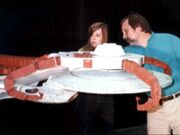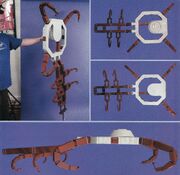(txt & pic.add.) |
Renegade54 (talk | contribs) m (copyedit) |
||
| (16 intermediate revisions by one other user not shown) | |||
| Line 12: | Line 12: | ||
The '''''McKinley'' type''' was a [[Starfleet]] orbital docking facility in use during the [[24th century]]. It was designed for [[starship]] construction, [[refit]]ting and maintenance layovers. ({{TNG|Family|All Good Things...}}; {{VOY|The Swarm}}) Facilities of this type were deployed at [[Earth]], [[Utopia Planitia Fleet Yards]], and [[Starbase 234]]. ({{TNG|Family|Redemption II}}; {{VOY|Relativity}}) |
The '''''McKinley'' type''' was a [[Starfleet]] orbital docking facility in use during the [[24th century]]. It was designed for [[starship]] construction, [[refit]]ting and maintenance layovers. ({{TNG|Family|All Good Things...}}; {{VOY|The Swarm}}) Facilities of this type were deployed at [[Earth]], [[Utopia Planitia Fleet Yards]], and [[Starbase 234]]. ({{TNG|Family|Redemption II}}; {{VOY|Relativity}}) |
||
| − | ==Facilities of the |
+ | ==Facilities of the type== |
'''Named''' |
'''Named''' |
||
* ''[[McKinley Station]]'' |
* ''[[McKinley Station]]'' |
||
| Line 28: | Line 28: | ||
** {{e|Relativity}} |
** {{e|Relativity}} |
||
** {{e|Author, Author}} (interior only) |
** {{e|Author, Author}} (interior only) |
||
| + | {{clear}} |
||
| − | |||
===Studio model=== |
===Studio model=== |
||
| − | [[File:McKinley type studio model on stage at Image G prepared by model maker Dana White and effects supervisor Dan Curry.jpg|thumb| |
+ | [[File:McKinley type studio model on stage at Image G prepared by model maker Dana White and effects supervisor Dan Curry.jpg|thumb|Model maker [[Dana White Shea|Dana White]] and VFX Supervisor [[Dan Curry]] with the models at Image G]] |
| − | The [[studio model]] was a [[Rick Sternbach]] design and built |
+ | The [[studio model]] was a [[Rick Sternbach]] design and built at [[Gregory Jein, Inc.]]. Sternbach utilized his newly acquired [[CGI]] modeling skills to design the structure on a computer, and made annotations on print-outs by hand for the construction drawings for Jein. ''({{dis|To Boldly Go|documentary}}'' – documentary) [[Gregory Jein]] noted on his build, "''The interesting thing about its crablike appendices is, that we sort of made them like a stop-motion armature so they could be flexible and custom fit any area of the ''[[Galaxy class model#Four-foot model|Enterprise]]'' so it looked like it was actually coming close to gripping the model.''" ([[TNG Season 4 DVD]]–special feature, "Select Historical Data") Jein constructed the model, which measured 32×73×15 inches, out of resin, acrylic sheet and fiberglass. The parts were held in place on a steel and aluminum armature with two mounting points, one on top of the model (for up-side-down filming, common at the time in {{w|motion control photography}} of physical studio models) and one aft. A single fluorescent hand-formed neon tube provided internal lighting through strands of fiber optic cables, though the lighting was restricted to the forward white colored "office"-section only. While both Jein's remarks and the design suggested that the station had four articulating appendices, these were actually rigid on the physical studio model. The appendices were not constructed to articulate, and to make positioning of the model of the ''Enterprise''-D and, later on the ''Sutherland'' as well, into the ''McKinley'' model that much easier, the aft port appendix was a removable piece, whereas the other three were permanently affixed. |
The model was only shot twice at [[Image G]], once for "Family" and once for "Redemption II", its later appearance in "All Good Things..." being stock footage (featuring previously unused extended footage shot for "Family", that was however, used in the 1991 documentary ''[[The Star Trek Logs: An MTV Big Picture Special Edition]]''). |
The model was only shot twice at [[Image G]], once for "Family" and once for "Redemption II", its later appearance in "All Good Things..." being stock footage (featuring previously unused extended footage shot for "Family", that was however, used in the 1991 documentary ''[[The Star Trek Logs: An MTV Big Picture Special Edition]]''). |
||
| − | [[File:McKinley type studio model after restoration.jpg|thumb|The ''McKinley'' |
+ | [[File:McKinley type studio model after restoration.jpg|thumb|The fully restored ''McKinley'' studio model]] |
| − | + | Missing its replaceable appendix, the physical model was acquired by American collector [[Adam Schneider]] as {{stala|6250|Lot 6250}} in the December 2007 ''[[It's A Wrap! sale and auction]]'' for a winning bid of US$810. [http://www.therpf.com/f10/earth-station-mckinley-56918/] Having deteriorated considerably during years of storage, Schneider decided to seek out help in order to restore the model to its former glory. [http://www.ncc1701.us/19.html] Professional modeler Jason Eaton, whose help Schneider sought out, commented upon receipt of the model: "''My first question out of the gate was, 'How much damage are we talking about?' with the second being, 'What reference do we have?' I quickly realized there was an amount of damage consistent with a fragile model being placed in storage (dust and general warpage from gravity and parts not designed for longevity, but for filming), and then there was additional damage sustained in shipping. Reference-wise, I had hoped for archival materials to surface, but those did not materialize. The repairs and reconstruction were therefore undertaken referencing DVD screen caps.''" (''[[Sci-fi & fantasy modeller]]'', Volume 12, 2009, p. 66) Eaton went on to describe step-by-step the elaborate restoration work he performed on the model. Further commenting on the restoration, Eaton has also made a general observation on studio models, "''Yeah, it's a weird design that should have gotten a better angle. I talked to Rick Sternbach about it a while back... Greg Jein's shop did the actual construction. Not a lot of ref out there, and there were some missing sections - luckily nothing that was impossible to extrapolate. Some of this is just mirrored from left to right along the model. I was most pleased with matching the (slightly aged) aztec coloring in the areas I repaired - you can't tell what was fixed from what was left alone. Also, it NEVER ceases to shock me how rough some of these models are, under close scrutiny. I know they're made under impossible deadlines, but man, some of those seam lines and bubbles in the castings made me cringe, when I left things untouched... you have to match what you're making to what exists!!''" [http://www.therpf.com/f10/earth-station-mckinley-56918/#post781904] |
|
| + | |||
| ⚫ | For its appearance in "Relativity", a CGI model model was constructed at [[Foundation Imaging]] by [[Lee Stringer]]. Stringer recalled,"''About 10 years ago this was the first CGI model I made for ''ST: Voyager'', I had no ref except the episode on [[VHS]]! I know what I made was far from the level of detail in the model, but it wasn't going to be seen close up.''" [http://www.therpf.com/f10/earth-station-mckinley-56918/#post785330] |
||
| ⚫ | For its appearance in "Relativity", a |
||
[[Category:Shipyards]] |
[[Category:Shipyards]] |
||
| + | [[Category:Space stations]] |
||
Revision as of 14:40, 19 September 2014
The McKinley type was a Starfleet orbital docking facility in use during the 24th century. It was designed for starship construction, refitting and maintenance layovers. (TNG: "Family", "All Good Things..."; VOY: "The Swarm") Facilities of this type were deployed at Earth, Utopia Planitia Fleet Yards, and Starbase 234. (TNG: "Family", "Redemption II"; VOY: "Relativity")
Facilities of the type
Named
Unnamed
- Facility in orbit around Starbase 234 (TNG: "Redemption II")
- Two facilities at Utopia Planitia Fleet Yards (VOY: "Relativity")
Appendices
Appearances
- TNG:
- VOY:
- "Relativity"
- "Author, Author" (interior only)
Studio model

Model maker Dana White and VFX Supervisor Dan Curry with the models at Image G
The studio model was a Rick Sternbach design and built at Gregory Jein, Inc.. Sternbach utilized his newly acquired CGI modeling skills to design the structure on a computer, and made annotations on print-outs by hand for the construction drawings for Jein. (To Boldly Go – documentary) Gregory Jein noted on his build, "The interesting thing about its crablike appendices is, that we sort of made them like a stop-motion armature so they could be flexible and custom fit any area of the Enterprise so it looked like it was actually coming close to gripping the model." (TNG Season 4 DVD–special feature, "Select Historical Data") Jein constructed the model, which measured 32×73×15 inches, out of resin, acrylic sheet and fiberglass. The parts were held in place on a steel and aluminum armature with two mounting points, one on top of the model (for up-side-down filming, common at the time in motion control photography of physical studio models) and one aft. A single fluorescent hand-formed neon tube provided internal lighting through strands of fiber optic cables, though the lighting was restricted to the forward white colored "office"-section only. While both Jein's remarks and the design suggested that the station had four articulating appendices, these were actually rigid on the physical studio model. The appendices were not constructed to articulate, and to make positioning of the model of the Enterprise-D and, later on the Sutherland as well, into the McKinley model that much easier, the aft port appendix was a removable piece, whereas the other three were permanently affixed.
The model was only shot twice at Image G, once for "Family" and once for "Redemption II", its later appearance in "All Good Things..." being stock footage (featuring previously unused extended footage shot for "Family", that was however, used in the 1991 documentary The Star Trek Logs: An MTV Big Picture Special Edition).

The fully restored McKinley studio model
Missing its replaceable appendix, the physical model was acquired by American collector Adam Schneider as Lot 6250 in the December 2007 It's A Wrap! sale and auction for a winning bid of US$810. [1] Having deteriorated considerably during years of storage, Schneider decided to seek out help in order to restore the model to its former glory. [2] Professional modeler Jason Eaton, whose help Schneider sought out, commented upon receipt of the model: "My first question out of the gate was, 'How much damage are we talking about?' with the second being, 'What reference do we have?' I quickly realized there was an amount of damage consistent with a fragile model being placed in storage (dust and general warpage from gravity and parts not designed for longevity, but for filming), and then there was additional damage sustained in shipping. Reference-wise, I had hoped for archival materials to surface, but those did not materialize. The repairs and reconstruction were therefore undertaken referencing DVD screen caps." (Sci-fi & fantasy modeller, Volume 12, 2009, p. 66) Eaton went on to describe step-by-step the elaborate restoration work he performed on the model. Further commenting on the restoration, Eaton has also made a general observation on studio models, "Yeah, it's a weird design that should have gotten a better angle. I talked to Rick Sternbach about it a while back... Greg Jein's shop did the actual construction. Not a lot of ref out there, and there were some missing sections - luckily nothing that was impossible to extrapolate. Some of this is just mirrored from left to right along the model. I was most pleased with matching the (slightly aged) aztec coloring in the areas I repaired - you can't tell what was fixed from what was left alone. Also, it NEVER ceases to shock me how rough some of these models are, under close scrutiny. I know they're made under impossible deadlines, but man, some of those seam lines and bubbles in the castings made me cringe, when I left things untouched... you have to match what you're making to what exists!!" [3]
For its appearance in "Relativity", a CGI model model was constructed at Foundation Imaging by Lee Stringer. Stringer recalled,"About 10 years ago this was the first CGI model I made for ST: Voyager, I had no ref except the episode on VHS! I know what I made was far from the level of detail in the model, but it wasn't going to be seen close up." [4]
